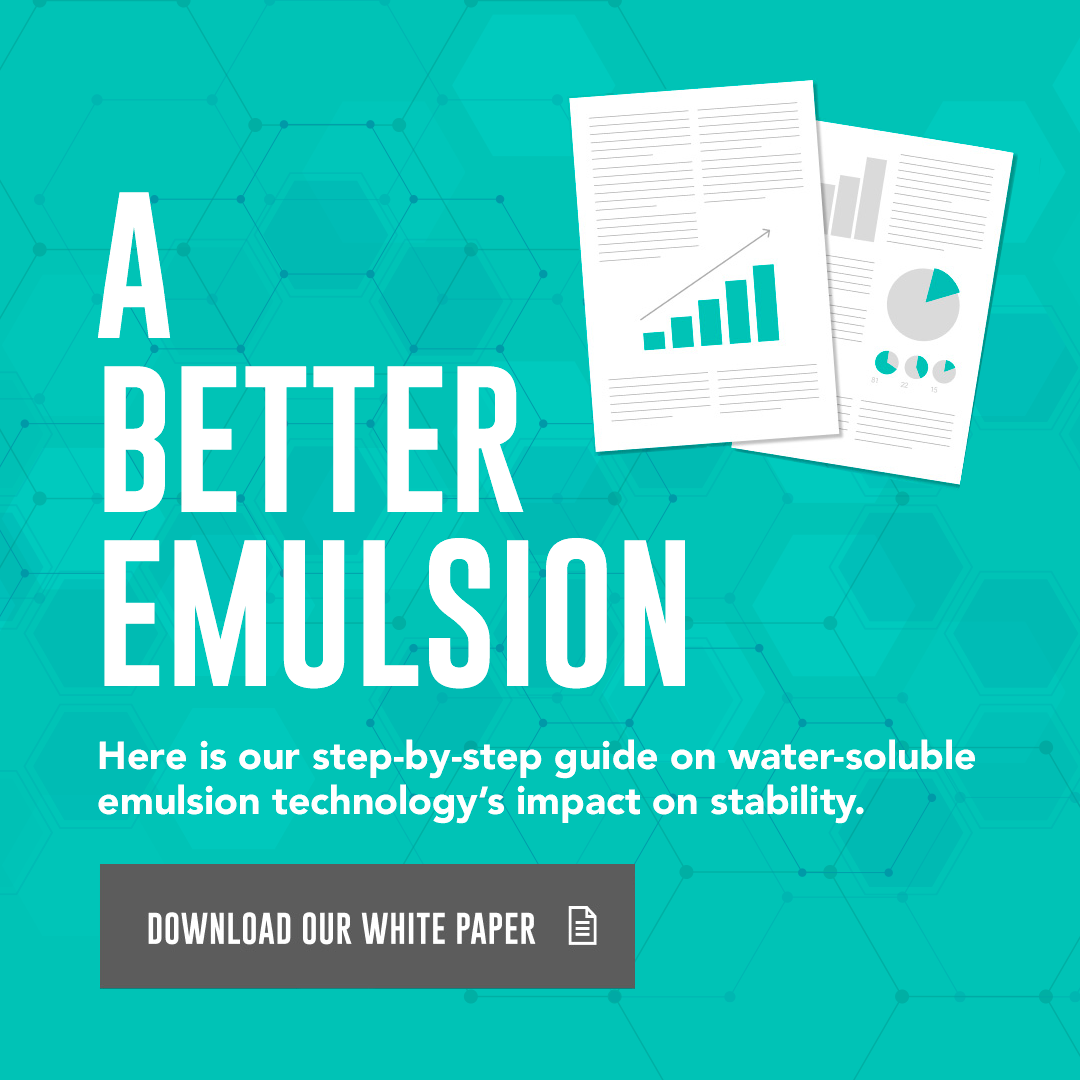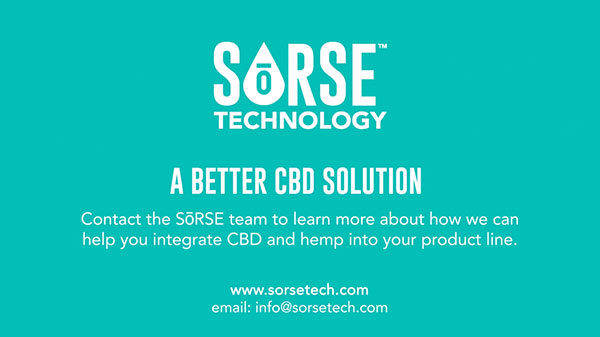When consumers try an infused beverage for the first time and pour the contents of the bottle or can into a glass, they might be surprised to find that the drink is hazy. That cloudy appearance can be attributed to the emulsion, the ingredient that disperses the cannabinoids such as CBD or THC into the beverage.
As CBD-infused beverages have become a mainstay on store shelves and consumers continue to seek products that deliver the CBD consistently AND taste great, emulsion technology continues to evolve. A result of this innovation is the use of clear emulsions in product development and production. Most beverage producers who choose a clear emulsion do so to create a certain visual aesthetic for their target consumer, especially those who are used to consuming clear drinks like sparkling waters, seltzers, or tonics.
As the infused food and beverage space continues to grow and more products come on the market, it’s important to understand the benefits and downsides of clear emulsions. The following are some frequently asked questions about clear emulsions, with answers from the SōRSE Science team.
Frequently Asked Questions on Clear Emulsions
Why do emulsion technology companies offer clear emulsions?
Companies offer these emulsions because clear beverages are widely known to the consumer, and they have a certain visual appeal. There are many beverages that consumers associate with being clear, like bottled spring water, sparkling water, club soda, tonic water, and some sodas. Then there are other beverages that consumers expect to be hazy, such as a not-from-concentrate fruit juice. Choosing clear over a standard emulsion is very much an aesthetic decision based on consumer expectations and demand.
How are clear emulsions with cannabinoids made?
To make a clear emulsion, there are three possible approaches:
1) Decreasing the particle size:
To reduce the particle size, you have to find a suitable emulsifier and increase processing time. The emulsion would have to reach a nano particle size to be clear.
2) Refractive Index Matching:
For Refractive Index Matching, the Refractive Index is a ratio of the speed of light through a medium (ie: water, air, oil, etc) to the speed of light through a vacuum. Emulsions appear opaque because the oil and water phase have vastly different Refractive Index (RI) values. In theory, if the RI of the oil and water phases can be matched, then the result should be a clear emulsion. In order for RI matching to work, you need to ensure that the ingredients in the oil phase are not soluble in the water phase, and vice versa, and that there are no chemical reactions between the oil and water phase.
3) Using cosolvents:
Using cosolvent/cosurfactant ingredients allow for the CBD to become miscible with water. With this approach, you have to find a cosolvent that, when mixed with the CBD, doesn’t lead to an opaque letdown into water. A good example of the cosolvent approach is with Ouzo and how it changes when dispersed into water – known as the Ouzo Effect.
In Ouzo, the dry anise-based liqueur, ethanol is the cosolvent that solubilizes the botanical oils. When Ouzo is diluted with water, the ethanol level drops, which makes the botanical oils less soluble. The oil droplets then disperse, which results in cloudiness or haziness. This method can also lead to bitter sensory qualities, which can be mitigated by adjusting the ratio of solvent to CBD as well as adding bitter blockers.
Once a clear emulsion has been created, it remains clear when introduced into water, and the sensory experience is favorable, the last phase of the process is proof of concept analysis — putting the emulsion in a number of different style beverages and experimenting with temperature to see how it will react in different formulations. Then the emulsion goes through microbial testing, potency testing, long-term shelf-life testing, and bioavailability analysis.
What are the downsides of using a clear emulsion?
These are some of the downsides to choosing Clear over Standard:
- The active ingredient is more vulnerable to degradation.
In a standard, cloudy emulsion, the active ingredient is protected because the oil particles are enrobed by the emulsifier, which means that not as much UV light can pass through the beverage. With a clear beverage, the cannabinoids are more exposed to light, which can lead to a quicker rate of degradation. If the emulsion begins to cloud up, the producer will need to consider the product’s shelf life and how the cloudiness will be perceived by the customer.
- It requires more R & D work on the front end of product development to ensure the final product is clear, so it might take longer to get the product to market.
In a clear emulsion, the oil loading of the active material is lower than in the standard emulsion, which means it will require more emulsion to get the same dose. Also, the ingredients used in a clear emulsion are not the same as those used in the standard emulsion, so product developers will need to test how the emulsion ingredients interact with the beverage ingredients.
If a product developer has been using the standard emulsion and wants to switch to a clear format, they may be limited in their use of certain ingredients to achieve the desired clarity.
Will the ingredients in the emulsion keep the product “clean label” and attractive for retailers? Are those ingredients safe for consumers?
In the US, the ingredients in most clear emulsions will keep the product “clean label” because they are deemed safe for consumers. In SōRSE’s standard and clear emulsions, all the ingredients minus the cannabinoids are Generally Recognized as Safe (GRAS) and have a long history of use in the Food and Beverage industry.
That said, if a company is looking to sell their products globally, there are ingredients that are not allowed in international markets. Most companies should have different formulas and ingredient options to meet different regulatory requirements.
What should a product producer look for when evaluating clear emulsions?
When evaluating clear emulsions, you should ask the following questions of the supplier:
- What ingredients are used in the emulsion?
Some ingredients should be used with caution or in low concentration until they have been tested and vetted by the FDA.
- Have long-term stability studies been done on the emulsion?
If the answer is yes, review the data with the emulsion supplier so you understand how the product’s stability will impact the beverage’s shelf life.
- How will a clear emulsion interact with the other ingredients in your beverage?
You will also want to ensure the sensory profile matches your beverage formula’s profile and that you will be able to control any bitter aspects of the emulsion.
Some ingredients will interact with emulsions whether clear or not, so it is important to do real life shelf testing with the infused finished product.
- What will a timeline for launching a product with a clear emulsion look like?
With a standard emulsion, some companies have been able to go to market in three months because it is relatively easy to plug the emulsion into the beverage formula. With a clear emulsion, it will likely take more time to work through the R & D process to make sure it’s compatible with the other ingredients and maintains its integrity through production.
As mentioned earlier, if a producer is looking to launch their product in international markets, it might take longer to get regulatory approval given different countries’ rules on certain ingredients.
- Is it easy for an emulsion provider to scale up a clear emulsion?
Depending upon the equipment and processes being used, scaling up can be challenging. For companies that use sonication and other forms of processing to create their clear emulsion, scaling can be difficult given the production capabilities of the machinery used – the sonicator. A sonicator creates vibration that reduces the particles to nano particle size. Sonicators work best for small batches of emulsion, but using this method for large batches is less reliable than the process SōRSE uses to create its clear emulsion.
Final Thoughts
For beverage producers who are eager to get a product on the market quickly, the standard hazy emulsion would be the best choice for a few reasons: Haze offers a great sensory profile, is compatible with high acidity, allows for higher loading, and is easy to add into the production process. Aesthetically, cloudy beverages are more the norm than they were a few years ago, likely due to the popularity of hazy craft beers.
For beverage producers who can take time to work through R & D to get their product to market and whose customers prefer clarity in their beverages, utilizing a clear emulsion is an obvious choice for an infused product.
Whatever your product development needs might be this year, SōRSE offers both standard and clear liquid emulsions for infused beverages.
Book a call with one of our team members to discuss what emulsion is right for you.





